 |
Valley County--1877 |
This is a NEGenWeb Project web page
and is presented as part of the
MARDOS Memorial Library Collection.
Valley County--1877
|
The first Czech homesteaders settled in Valley County in 1877, in Geranium and Michigan Townships, and that was the nucleus of the large settlement now spreading over Valley, Custer and Garfield counties, numbering 600--700 families. The larger part of these live in and about Ord, Valley County, the vicinities of Elyria, North Loup and Arcadia being comparatively small. In Custer County they live in the vicinity of Sargent (about 60 families) and Comstock (75 families), both towns lying near the boundary of Valley County. In Garfield County they are scattered over a large territory and have practically no community life excepting the 50--60 families living in and around Burwell, which meet with those in Valley County and use their cemeteries. Matej Vacek, son of Martin Vacek of St. Paul, Nebr., explored the country in 1876 and told his friends it would be a good place in which to settle. The next year, 1877, with his father and brother Jacob they took homesteads, in Michigan and Geranium townships. 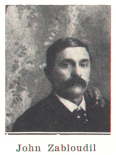
1877--The Following Came, Besides the Vaceks: John Vobornik; John Zabloudil was born April 20, 1852, in Humpolec, Bohemia, where he married and then emigrated to this country. He farmed in Valley County and was a prominent worker in patriotic and lodge activities. About 1903 he moved to Oklahoma and died there April 13, 1913, but was buried in Ord, in accordance with his wishes. John Valis; Vaclav Studlar, born in Kralovice, Prachatice; Matej Vavra, born in Driten, Budejovice; Frank Vavra, same place. 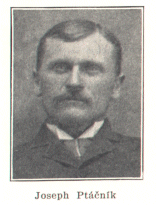
1878--The Following Came: Joseph Ptacnik, born in Vyhlava near Budejovice. He came from Spillville, Iowa. He and John Valis helped to establish the Catholic parish and cemetery in Netolice (Geranium). John Rybin, Ostasovice, Kostelec, came from Jackson County, Iowa; Frank Vopat, born in Chotina, Plzen; Vojtech Hosek, born in Dasny, Hluboka, came from Wisconsin. 1879--The Following Came: 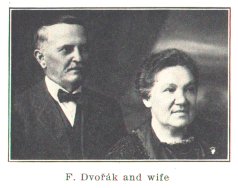
John Beran, born in Sendrazice, Kolin. He came by wagon from Minnesota. He established the postoffice Sedlov, in n. e. quarter 5-19-16, Geranium Township, and was postmaster there for six years; Joseph Princ, Zbor, Pacov; Joseph Cerny, came from Linwood, Butler County; John Flieder; Joseph and Paul Zurek, born near Vyzovice, Novy Jicin; Joseph Pacas, born in Nasledovice, Zdanice. Living now in Garfield County. Charles Severin, Hlinsko, Chrudim. He came from Schuyler; Vaclav Holoun, Chrtice, near Caslav. Came to Omaha in 1874. Matej Beroun, Jaromerice, Morava; Frank Hosek, born in Dasny, Hluboka. Came from Spillville, Iowa. Joseph Stara, Bahno, Kutna Hora; Fr. Scheinost, Usilov, Nova Kdyne; Louis Dohnal, Viterov, Zdanice; Joseph Skolil, Pavlov, Unhost; Charles Svoboda, Jaromerice, Brno. 1880--The Following Came: Vaclav Mottl, born in Chrtice near Caslav. He preempted for $100, and used to walk sixty miles to Howard County, to work. Charles Cesak, Nebylov, Blovice, came from Iowa; Matej Novotny, Precice, Trebon, came from Iowa; Joseph Kokes, Bela, Telc, father of Vincent Kokes, one of the first Czech inhabitants of Ord and county clerk for three terms. 1881--The Following Came: 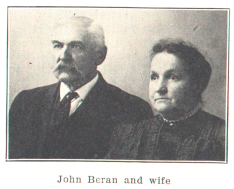
Vojtech Lukes, M. Porizanky, Vltavotyn, came from Spillville, Ia.; Joseph Valasek, Zelichovice, Vyzovice; Andrew J. Krikac, Luzany near Prestice, later one of the first Czech settlers in Custer and Cheyenne Counties, now living in Butte, Boyd County; Vojtech (Albert) Parkos, Podoly, Pisek, came to St. Louis in 1877; Matej Klima, born in Sobedraz. near Tabor, came to Conover, Iowa, in 1873, to St. Paul, Nebr., by rail, then by ox team. Lost part of his property in 1882 by a prairie fire. He arrived with family the winter following the heavy snow, when the Union Pacific bridge had been carried away in the spring, so they crossed over the temporary bridge made of rope. 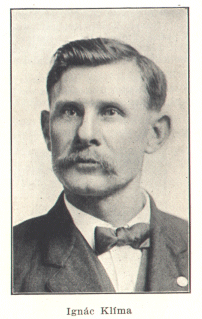
Ignac Klima, a son of Matej Klima, was born July 21, 1869, in Bohemia and died in Ord, Nebr., January 1, 1923. He was fourteen years of age when he accompanied his parents on their way from Conover, Iowa, to Nebraska, in a prairie schooner. A year after their arrival the father died and Ignac, though little more than a child, became his mother's sole support. Thus he can be considered a pioneer also, for he helped to till the virgin prairie and take the produce to North Loup, the nearest railroad station, by ox team. On February 25, 1892, he married Miss Mary Vodehnal and fourteen children were born to them. Ignac Klima left the memory of a good patriotic and lodge worker. 1882--The Following Came: Jacob Kosmata, born 1838 in Litohradice, came to Conover, Iowa, in 1866, to Howard in 1882, still living; Thomas Vodehnal, born in Sec, Skuc, Chrudim, came to Iowa in 1874; Matej Vandas, Divcice, Hluboka; Joseph Hrdy, born in Velenov, Nalzova, came from Kansas. 1883--The Following Came: Joseph Klat, Litomysl, came to Cedar Rapids, Iowa, in 1877; John Valasek, Zelichovice, Vyzovice; Bartholomew Krikac, Luzany near Prestice. 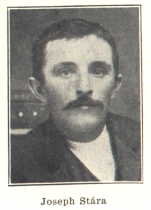
1884--The Following Came: Matej Parkos, Podoli, Pisek; John Pecka, born 1833 in Prague, came to Calmar, Iowa, about 1864, living; Vaclav Parkos, Podoli, Pisek; Matej Scheinost, Usilov, Nova Kdyne; Frank Benda, Trebenice, near Pisek; John Benda, same; John Sedlacek, Dlouha Louka near Prestice, living. 1885--The Following Came: Jacob Hvezda, Hradiste, Nova Kdyne; Joseph Polak, Michalovice, Ledec; Joseph Mares, Radic near Tabor; Anton Koupal, Sedlovice, Netolice. He came to Indiana in 1868, and was the father of Frank Koupal, county and district court clerk. Other Old Settlers Were: Joseph Trubl, Krtenov, Vltavotyn; Martin and Frank Papousek, Volsena, Trebon; George Sestak, Zimor, Melnik; Vaclav Urban; Vaclav and John Kluna; Frank and Louis Kamarad, Jihlavka, Telc, Jihlava; John Mares, Radic, near Tabor; John Fisher, Lukavec, Pacov. The first Czech inhabitants of Ord, the county seat, were--Joseph Slobodny, who first dealt in agricultural implements and horses, later had a saloon and then moved to St. Paul. He was born in Ponedraz. Frank Misko, born in County Hlinsko, came to Minnesota in 1876 and after marrying Mary Rayman they came to Ord in 1882. He established a harness shop there and is still active, helping his sons. Member of city council and prominent in civic life. 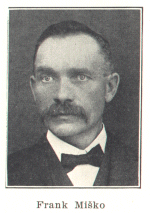 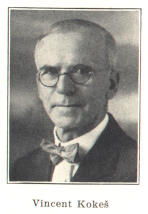 Vincent Kokes, born in Bela, County Pelhrimov, March 16, 1866. He studied in Telc, Moravia, came to America in 1881, directly to Ord, where at the time but two Czechs, Joseph Slobodny and John Lukes, were living. They moved away shortly, only Kokes remaining. He worked two years in a drug store, then in other towns until 1887, when he returned and conducted his own drug store until 1893. He was elected county clerk that year and served six years, the first Czech county official. Then be became cashier of the Ord State Bank for six years and for fourteen years was president of same. In 1892 he married Miss Lydia Ledvina of Wahoo and has one son, now assistant cashier in a bank in Scotia, Nebraska. Frank Dvorak, who came in 1886 from Schuyler and has been a prominent business man for many years. The country about the North and Middle Loup rivers began to attract settlers as early as 1870-1871, but none settled in that vicinity until 1872 and then some left. These first settlers lived along water courses, water being a most important consideration. There is water in every foot of land in that country, but it is so-called "sheet water" and the rivers absorb it. Water is found in many layers of sand, gravel and sandstone, but as the land rises above the water courses, it is harder to get and sometimes very deep wells must be dug. The homesteaders did not have the money to overcome this difficulty, so the higher lands remained unoccupied longer than did those lower and nearer streams. Many of the first Czech homesteaders took timber claims, just to hold them for their friends, and then left the country. This was true of the Vaceks and others from St. Paul, Howard County.   In all of the fifty-six years since this country began to be settled, there was never as severe a blizzard as that of 1888. Vencl Krikac Sr., now living in Comstock, who has furnished data for the history of this county, writes: "I had often heard of bad blizzards, but this outvied them all in the suddeness with which it came, the velocity of the wind, the severity of the cold, and the amount of snow on the ground and in the air. H. W. Foght, in his book 'The Trail of the Loup', says: 'The storm struck Burwell at 12:35 M and the thermometer fell to 25 degrees below zero by four o'clock P. M.' Seventeen farmers in Valley County sought shelter in haystacks, but not one person in that county perished. Fifteen people froze in Custer County. I was out in that storm and remember it well. The day was cloudy, as if snow might fall, but balmy, so that many people were away from homes after their business. Our postoffice was Sedlov, two miles north, and six miles east was the postoffice Geranium. There was a small store there, where we went at times in winter. A road led from my house about forty rods east, where it connected with the public highway going south. About 120 rods along this highway is a section corner, where roads cross each other. On the opposite corner stood a frame district-school building. The road east from there was used when going to Geranium. Thus, the road from our house led 120 rods north and 40 rods west. I was to go to Geranium that day and after an early lunch my brother Andrew and I set out, the younger children being in school. The ground was covered with snow fallen some time before, and as we started, snow was again falling in large flakes, but soon stopped. As we glanced to the northwest, we did not see anything unusual, except that the clouds were somewhat darker. We had gone about 70 rods east of the school when I happened to look up and saw great clouds of snow advancing with the rapidity of flames. In an instant we were covered by it and turned home. The noise of the wind and driving snow was so great that no other sound could be heard. It was certainly louder than we hear, sitting by an open train window, when one train rapidly passes another. We reached home safely, but remembered then the children in school. We had left the wagon near the sod barn, but it was impossible to harness the horses, on account of the wind. We put them back in the barn and drew the wagon close against a frame granary, where we finally succeeded in harnessing the team to a wagon with a double box and I set out. The public highway south was only 18-20 feet wide and on the east of it was a high cornfield, which helped in directing me. I took all the children except two and the teacher (they too reached home in safety) and resumed the homeward journey, along the cornfield, although I had to wipe my eyes continually, being blinded by snow. My brother met me and took the reins out of my stiff hands. Although he stood not more than eight feet away from the wagon, I had not seen him, nor knew he was there until he shouted. When I changed my clothes at home, I found fine snow even on my underwear." A deep snow fell during the winter of 1880-1881. It was impossible to get anywhere with a team. There was a watermill in Ord, ten or twelve miles distant, but when the water froze, naturally it did not work and this was true of other mills down the river. Owing to the condition of the roads, it was impossible to convey flour from Grand Island. The first brought from there in the spring was gone in a few moments and a Czech, Joseph Princ, carried a fifty-pound sack sixteen miles to his family, for even then it was impossible to get to Ord with a team. Some of the first Czech homesteaders used to walk to Howard County, indeed some even to Omaha. John Rybin made the latter trip several times. Frank Kriz walked from Custer County to Omaha and back a number of times. |
| Back | Table of Contents | Next |